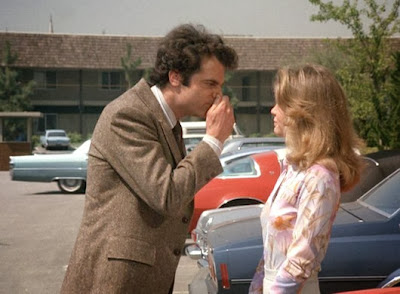We all have them – TV shows we enjoy despite prevailing opinion and common sense telling us they are a waste of time.
I have amassed more than most people, which can be attributed either to an uncommonly forgiving nature or just questionable taste.
Take Tabitha, a failed spin-off that lasted 12 episodes and would not be considered a career highlight for anyone involved. I bought the DVDs and have watched every show more than once. I see the flaws, but there’s also a tangible Comfort TV component as well, partly due to its pedigree.
If you care enough about television to have found this blog, you probably know that Tabitha was inspired by Bewitched and follows the grownup adventures of Samantha and Darrin Stephens’ first-born.
A bit of SORAS-ing (soap opera rapid aging syndrome) was necessary to make the concept work. If Tabitha was “born” in 1966, on the “And Then There Were Three” episode of Bewitched that aired that year, she would have only been 11 in 1977, when this series debuted. That’s why Erin Murphy, the original Tabitha, could not reprise her role.
One of the series’ drawbacks was never deciding how beholden it wished to be to its TV roots. The opening credits sequence, featuring a Bewitched clip and the Stephens’ photo album, suggested a close connection. But it then rewrote the family history by changing Tabitha’s younger brother Adam into her high-strung, perpetually exasperated older brother.
The objective was to recreate the Sam and Darrin dynamic with siblings; Tabitha was the lovable witch trying to stay off the magic, and Adam the skittish mortal always beset by his sister’s powers. The strategy was doomed from the start, as viewers never felt the affection beneath the scolding – Adam just comes off as a pill.
Guest stars were dispatched to reinforce the Bewitchedconnection; Dr. Bombay makes a house call in “Tabitha’s Weighty Problem,” and instigates the only genuinely funny scene in the series. And the Kravitzes, both nearly unrecognizable from their Morning Glory Circle days, pay a visit in “Arrival of Nancy.” George Tobias (Abner), spotting a full gray beard, appears to have wandered in from Fiddler on the Roof.
Of course, had Samantha stopped by to see her “daughter” Tabitha would be in a lot more DVD collections. But when Elizabeth Montgomery closed that door she never looked back.
Aunt Minerva, a new meddling relative in the Endora mold (Agnes Moorehead died in 1974) was played by Karen Morrow. Once hailed as the heir to Ethel Merman for her incredible singing voice and charismatic stage presence, Morrow had the misfortune of showcasing her considerable talents in one Broadway flop after another. Eventually she moved to Hollywood where her bad luck continued. Her Minerva was the worst component in an ill-fated series.
So what’s to like about Tabitha?
It starts with Lisa Hartman, whose enthusiasm never wavered and who one could see making the character work with better material. The show’s writers, perhaps sensing they had a turkey on their hands, never missed a chance to put her in short skirts, cheerleader costumes, hot pants and towels to distract male viewers from the jokes that weren’t working.
Hartman was always beautiful and still is, but here, with feathered Farrah hair and before the nose job she never really needed, she makes an utterly charming Tabitha Stephens. This job also launched her singing career (that’s her voice you hear in the show’s catchy theme), which eventually blossomed with help from Knots Landing and husband Clint Black. Her 1982 “Letterock” album is first-class ‘80s pop rock.
As a lothario TV host at the local station where Tabitha works, Robert Urich also deserves praise for basically inventing Ron Burgundy 30 years before Will Ferrell. Urich had comedy chops to go with his leading man looks; they were better served on Soap, but like Hartman he emerged from the show unscathed and on to greater glories.
I really love the glimpses we get of his character’s apartment, with its huge square-shaped couch, chrome light fixtures, wet bar and waterbed with animal-print comforter. Watch for it in the pilot – this could be the quintessential swanky 1970s bachelor pad.





